
Searching for Sugarlandia – The Philippines with Don Papa Rum
I’ve always been captivated by the stories behind Scotland’s whiskies. Tales of illicit stills, brave pioneers, families working together and on occasion tearing each other apart, have always been whispered on the wind that sways the fields of barley and in the rushing rivers that provide the crystal-clear water that make Scotch whisky. Today, they may be more likely to be told by guides in hi-tech, custom-built visitor centres, but the legends are no less addictive. It is this history that enriches the experience of drinking whisky and makes visiting distilleries an irresistible pass time.

So, when I was invited to travel to a place called Sugarlandia to discover the story behind Don Papa rum my interest was piqued. When I learned that the dapper fellow who graces the label of Don Papa rum, along with a menagerie of Filipino flora and fauna, was a revolutionary hero named Papa Isio who fought to free the Philippines from Spanish rule in the 1890s, it’s safe to say that my imagination was well and truly captured.
Travelling all the way to the Philippines gave me plenty of time to dream about the exciting tales that might emanate from the sugarcane that is key to rum production and that grows so prolifically on the island of Negros Occidental, or Sugarlandia, as it is colloquially known.
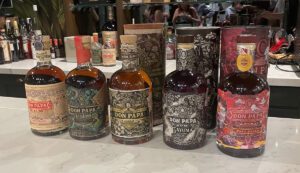
The Don Papa range
An hour-long flight from Manila over just a few of the 7,641 islands that make up The Philippines sees me in Bacolod, the capital city of Negros Occidental. But in order to discover Sugarlandia we must head south. As we leave behind the office blocks and hotels the streets narrow and I’m captivated by row upon row of homes of all colours, shapes and sizes that line the roadside. Here there are schools, restaurants, street food stalls and shops which all seem to be named for their owners. Dogs regularly run the gauntlet that is crossing the road, dodging peeping cars, motorcycles and bikes with sidecars while shimmering roosters proudly oversee proceedings from their high wooden perches.
Fields of sugarcane of varying heights spring up as we go. We are in the shadow of Mount Kanlaon, an active volcano that straddles the provinces of Negros Occidental and neighbouring Negros Oriental. It is partially due to the rich volcanic soil of the island that sugarcane grows so well in this part of the Philippines.
Hacienda Santa Rosalia is a welcome sight as the heavens open, providing us with an idea of why this island is so very lush and green. This is the ancestral home of the Gaston family in Manapla. The house was built in 1936 by Victor Gaston who established a sugar plantation here and Victor’s grandson, Joey is waiting to welcome us. The colonial style house quickly whisks me back to another time as we dine at the grand old table on china crockery surrounded by family portraits and cabinets of antique curiosities. Joey explains that Filipinos always want to share food, something that will be verified many times over during my time in the Philippines, and we laugh at how in Scotland we’re more likely to tell someone that ‘you’ll have had your tea’!
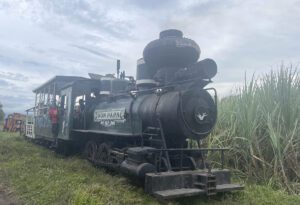
Our next stop sees us board a steam train and journey along a section of line into the jungle en route to the Hawaiian-Philippine Company sugar mill. Giant palm leaves brush my ears as the old engine devours gigantic logs as it steams deeper into the trees before finally emerging into a seemingly endless sea of sugarcane. Chomping on a sweet and juicy piece of the cane we can see the mill where the sugar is refined and where the molasses that are used to make Don Papa rum are produced as a byproduct. Harvesting of the cane is still done in the traditional way, with a scythe, and domesticated water buffalo are employed to carry the cane to the lorries that transport it to the mill for processing.
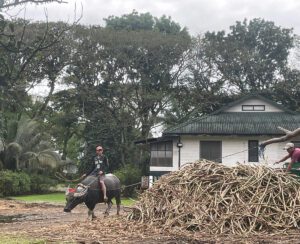
As already mentioned, I’m partial to a distillery visit. So, touring the Bago Distillery and discovering the ex-bourbon American oak casks in which Don Papa rests for seven years before bottling is a real treat. As is tasting the spirit at its various stages of maturation. Scots may consider the Filipino angels a tad greedy when they discover that in the heat and humidity of Negros Occidental their share of each cask is around 8-10% (compared to just 1-2% in Scotland)! They may also be interested to know that a new Don Papa expression named Gayuma, which is matured in Islay whisky casks is likely to be launched in the UK this year.
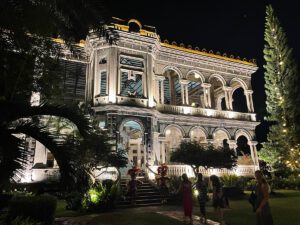
The Ruins
The evening brings another treat in the form of a spectacular dinner at The Ruins. The remains of the ancestral mansion of wealthy sugar baron Don Mariano Ledesma Lacson – which he built in memory of his late wife in the early 1900s, when she died giving birth to their eleventh child – is a popular tourist attraction. But tonight, local delicacies, Don Papa cocktails and music light up what remains of the building which was set alight to prevent invading Japanese forces using it as a military office during World War II.

Masskara Dancers
The colour and energy of the local dancers who usually perform at the annual Masskara festival are a real highlight and it’s easy to believe what our new-found Filipino friends say about how as a nation they are always ready to celebrate. The origins of this particular festival, which has a Don Papa expression named for it, date back to 1980. This was a time of great financial hardship and in the aftermath of a tragic shipwreck that saw many lives lost, the President of the Arts Association in Bacolod, Ely Santiago conceived the celebration as an expression of hope and optimism. Our own Don Papa fuelled celebrations go on long into the night and at some undefined point transfer to a local tractor-themed bar!
The morning dawns warm and slightly fuzzy as we make for the beach. Punta Bulata, on the southern heel of Negros island is an idyllic paradise, with large luxurious rooms, a beachside bar and restaurant and an infinity pool all looking out over palm-lined white sands to the turquoise Sulu Sea. After the sensory overload of Manila and the excitement of discovering all of the places that make Don Papa the rum that it is, some R&R is most welcome. I’d recommend starting to wind down with a full body massage in the comfort of your room, followed by a Don Papa Pina Colada to accompany the insanely beautiful sunset.
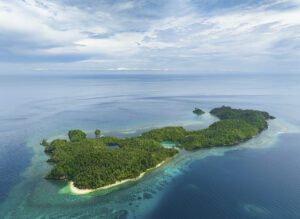
Danjugan Island
A snorkelling trip to the nearby island of Danjugan, a marine-reserve and sanctuary, allows us to discover some of the wildlife of The Philippines. From the colourful sea creatures who inhabit the coral reef, to a cave full of fruit bats also playing host to a carefully coiled python waiting patiently to snatch an unlucky supper as it flies from its roost.
Memories of the previous night’s festivities are brought back to the fore when Tomas, the owner of Punta Bulata presents me with the juiciest looking mango, already perfectly hedge-hogged on a plate. I’d told him over cocktails that I couldn’t wait to try the local mangoes, as I’d heard how wonderful they were. He, of course had agreed and told me he knew where to find the best in Negros. And true to his word, he had stopped off to get some to make sure I could try out the best of the best. And I’ll forever be grateful that he did. Filipino mangoes are indeed the best in the world. You heard it here first.
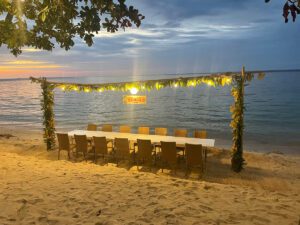
Preparing for a Boodle Fight at Punta Bulata
Dinner at Punta Bulata sees us enjoy a ‘boodle fight’ on the beach. The table is covered in banana leaves and we’re invited to forego crockery and cutlery and dig into the feast of rice, fresh seafood, chicken and veggies. All of this is washed down with a fresh coconut, enlivened with a shot of Don Papa Masskara. This spiced rum is sweet with honey, calamansi (cute mini limes that are a Filipino staple) and siling labuyo chilli peppers. I’ve drunk many cocktails in my time but I’d struggle to find one I’ve enjoyed as much as this one, right here in the warmth of the evening with the sound of the waves gently breaking on the sand.
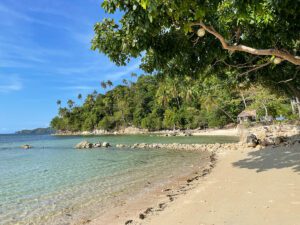
Beautiful Punta Bulata
Leaving Punta Bulata is a wrench, but we’re Manila bound once again and a couple of nights spent at The Fairmont in Makati are very far from a hardship. We have time to take a tour of Intramuros and Fort Santiago with the lovely Eddie, a font of knowledge on Filipino history. The Philippines was under Spanish rule for 300 years, British for two, under Japanese control during World War II and then spent 50 more years under the governance of the US, so there is a wealth of tales to be told.
And that brings me to the end of my story. An undeniably saccharin tale of sprawling cities, of fields of sugarcane nurtured by the beating sun and tropical storms, of perfect beaches where palm trees sway in the breeze and coral reefs teem with life. But the protagonists in this story are without a doubt the Filipino people. And I’ve no doubt that the warmth of their welcome and their ready smiles are just waiting to be discovered when you’re ready to write your own tale.
WHERE TO STAY
Punta Bulata Resort & Spa, Barangay Elihan Cauayan, Negros Occidental 6112
Paradise on the Sulu sea.
Fairmont Makati Manila 1 Raffles Drive, Makati Avenue, Makati City 1224
High-end luxury hotel with a rooftop pool and a breakfast buffet selection to die for.
WHERE TO EAT AND DRINK
Lampara, 5883 Enriquez, Makati, 1210 Metro Manila
The perfect place to start your journey into Filipino cuisine. Small plates and delicious cocktails. This is where I discovered the joy of deep-fried pigs’ intestine (seriously good) and the wonder of pork floss.
Toyo, The Alley at Karrivin Plaza, Chino Roces Extension, Makati, Manila
Fine dining Filipino-style.
The Spirits Library, 4963 Guerrero St, Makati
Cool cocktail bar with a vertiginous and impressive wall of spirits to choose from.
TAGS

